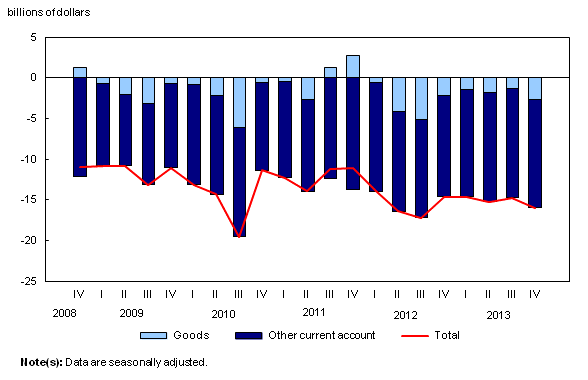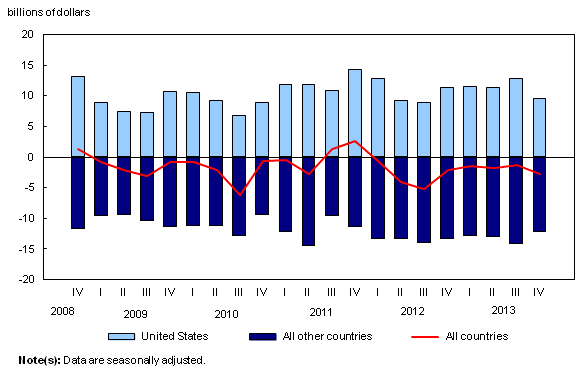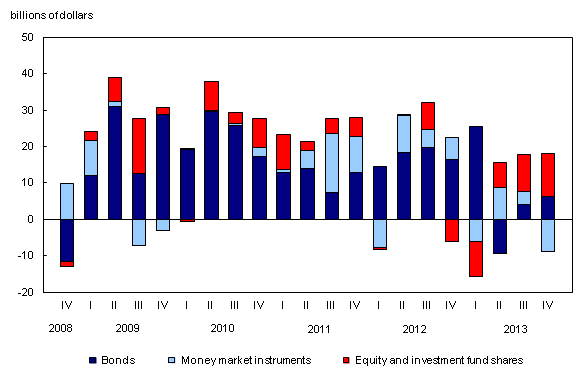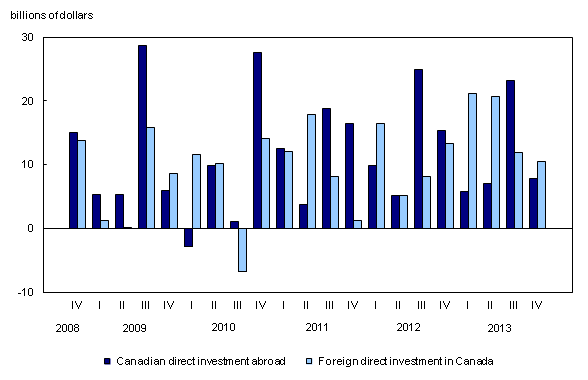Canada's balance of international payments, fourth quarter 2013
Archived Content
Information identified as archived is provided for reference, research or recordkeeping purposes. It is not subject to the Government of Canada Web Standards and has not been altered or updated since it was archived. Please "contact us" to request a format other than those available.
Released: 2014-02-27
Canada's current account deficit (on a seasonally adjusted basis) increased $1.2 billion to $16.0 billion in the fourth quarter. This increase was mostly because of a larger deficit on trade in goods.
In the financial account (unadjusted for seasonal variation), increased foreign currency deposits held by non-residents in Canada led the inflow of funds from abroad in the quarter.
Current account
Deficit on trade in goods widens
The deficit on international trade in goods widened $1.4 billion to $2.7 billion in the fourth quarter, as exports fell and imports moved higher. The trade surplus with the United States was down by $3.3 billion on stronger imports (up $2.4 billion) and weaker exports, both sides led by changes in crude petroleum. The narrowing in the deficit with the rest of the world had a moderating effect, as imports of crude petroleum were down $1.6 billion.
Overall exports of goods were down $0.9 billion to $120.1 billion. Lower prices for crude oil largely accounted for a $1.9 billion reduction in exports of energy products. Crude petroleum declined $2.2 billion, while natural gas edged up on higher prices. Metal and non-metallic mineral products exports were down $0.5 billion, reflecting lower volumes of precious metals. These reductions were moderated by a $0.6 billion increase in exports of farm, fishing and intermediate food products, principally on higher volumes of canola.
Total imports of goods were up $0.5 billion to $122.9 billion. Consumer goods as well as transportation equipment and parts both rose by $0.3 billion. However, imports of energy products were down $0.2 billion, marking a fourth straight quarter of decline. This activity reflected lower purchases of crude oil and natural gas, partially offset by higher volumes of refined petroleum energy products.
Lower deficit on trade in services
The overall deficit on transactions in services narrowed $0.3 billion to $5.9 billion in the fourth quarter. Commercial services accounted for most of this activity. The surplus on commercial services rose $0.3 billion led by higher exports, mainly from technical and other business services. However, the deficit on international travel edged up $0.1 billion, largely reflecting the increase in the number of Canadians travelling abroad.
Investment income deficit expands
The deficit on cross border investment income was up $0.3 billion to $6.1 billion in the fourth quarter, with most of the changes related to foreign direct investment.
On the investment income payments side, profits earned by foreign direct investors on their operations in Canada increased $0.9 billion. In addition, interest paid to non-residents on their holdings of Canadian securities recorded a slight increase of $0.1 billion, mainly related to payments due and accrued on foreign currency-denominated corporate bonds.
On the receipt side of the ledger, earnings by Canadian direct investors on their operations abroad were up $0.5 billion. Canadian portfolio investors also saw higher earnings, up $0.2 billion on higher dividends and interest.
Financial account
Foreign investment in Canadian securities focuses on equities
Foreign investment in Canadian securities amounted to $9.2 billion in the fourth quarter. Activity was led by a $12.0 billion acquisition of Canadian stocks, the largest such investment since the third quarter of 2009. Canadian stock prices were up 6.5% in the quarter.
However, foreign holdings of Canadian debt securities fell by $2.7 billion, the largest quarterly divestment in over eight years. Foreign investors withdrew $8.9 billion from the Canadian money market, mainly retirements of federal Treasury bills. At the same time, they added $6.2 billion of Canadian bonds, mostly corporate bonds denominated in US dollars. Non-residents' holdings of Canadian government bonds were down for a third straight quarter.
Foreign investment in Canadian securities slowed considerably in 2013 compared with the previous four years. Foreign investors acquired $42.8 billion worth of these instruments in 2013, down from an annual average of $102.0 billion between 2009 and 2012. The investment focus also shifted in favour of corporate securities in 2013, as overall government borrowing activity slowed in comparison with the 2009 to 2011 period.
Canadian investment in foreign securities accelerates
Canadian investors purchased $11.3 billion of foreign securities in the fourth quarter, the largest investment in a year. The bulk of the activity was in foreign bonds, mainly US government bonds. The Canadian dollar depreciated against its US counterpart in the quarter, down US 3.0 cents.
Canadian investors have increased their holdings of foreign bonds in each of the past two years, following four years of straight divestment, when concerns over the global financial outlook were prevalent. In 2013, acquisitions of foreign debt instruments exceeded those of foreign shares for the first time in seven years. Nevertheless, Canadian portfolio investment assets remain strongly tilted toward equities.
Outward and inward direct investment slows
Canadian direct investment abroad amounted to $7.9 billion in the fourth quarter, down from $23.2 billion in the third quarter. Outflows related to mergers and acquisitions slowed and accounted for $3.6 billion of this activity, mainly in the United States. On an industry basis, Canadian direct investors placed the bulk of the funds in the finance and insurance industry.
Foreign direct investment in Canada was $10.4 billion, down slightly from the level of activity in the third quarter. Inflows related to mergers and acquisitions remained subdued for a third straight quarter at $2.1 billion.
For the year, foreign direct investors injected $64.2 billion of funds into the Canadian economy. The largest such annual inflow since 2008 was led by investment in the manufacturing and the energy and mining industries. Inward direct investment exceeded outward direct investment for the first time in six years in 2013.
Transactions in the banking sector generate large inflow of funds
With transactions in direct and portfolio investment largely offsetting each other, activity in the other investment category of the financial account generated a net inflow of funds of $20.1 billion in the fourth quarter. This mainly reflected an increase in currency and deposits, largely foreign currency deposit assets of foreign financial institutions and other non-residents in Canada.
Note to readers
The balance of international payments covers all economic transactions between Canadian residents and non-residents in three accounts: the current account, the capital account and the financial account.
The current account covers transactions in goods, services, compensation of employees, investment income and secondary income (current transfers).
The current account data in this release are seasonally adjusted. For more information on seasonal adjustment, see Seasonal adjustment and identifying economic trends.
The capital account covers capital transfers and transactions in non-produced non-financial assets.
The financial account comprises transactions in financial assets and liabilities.
In principle, a net lending (+) / net borrowing (-) derived from the sum of the current and capital accounts corresponds to a net lending (+) / net borrowing (-) derived from the financial account. In practice, as data are compiled from multiple sources, this is rarely the case and gives rise to measurement error. The discrepancy (net errors and omissions) is the unobserved net inflow or outflow.
For more information about the balance of payments, consult the "Frequently asked questions" section in the System of macroeconomic accounts module of our website. The module also presents the most recent balance of payments statistics.
The balance of international payments data for the first quarter will be released on May 29.
Contact information
For more information, contact us (toll-free 1-800-263-1136; 514-283-8300; infostats@statcan.gc.ca).
To enquire about the concepts, methods or data quality of this release, contact Denis Caron (613-951-1861; denis.caron@statcan.gc.ca), International Accounts and Statistics Division.
- Date modified:





